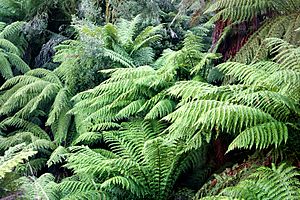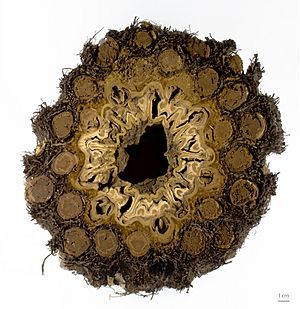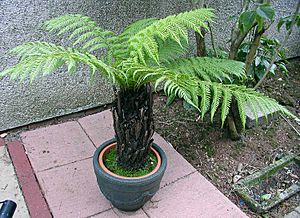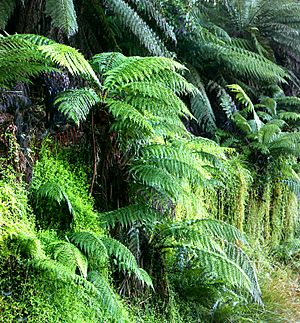Soft tree fern facts for kids
Quick facts for kids Soft tree fern |
|
|---|---|
 |
|
| Gippsland, Australia. | |
| Scientific classification | |
| Genus: |
Dicksonia
|
| Species: |
antarctica
|
The soft tree fern, also known as Dicksonia antarctica or man fern, is a type of tree fern. It stays green all year round. This fern naturally grows in eastern Australia. You can find it in places like south-east Queensland, coastal New South Wales, Victoria, and Tasmania.
Contents
About the Soft Tree Fern
These ferns can grow quite tall, up to 15 meters (about 50 feet). But usually, they are around 4.5 to 5 meters (15 to 16 feet) tall. The fern has a trunk that is actually made of old, decaying plant parts. This trunk is very hairy at its base.
The soft tree fern has large, dark green leaves called fronds. These fronds have a rough feel and spread out like a big umbrella. This canopy can be 2 to 6 meters (6 to 20 feet) wide. Sometimes, the trunks grow in curved shapes, and some ferns even have multiple tops. New fronds grow in batches. You might see layers of fronds that produce spores mixed with layers that don't.
The "trunk" of this fern is not like a tree trunk. It's really just the old parts of the plant that have died and decayed. The roots of the fern grow through this material. Usually, each fern has one trunk, but sometimes small new plants can grow from its base. If you cut down the top part of the fern and keep it wet, it can grow new roots and become a new plant. However, the bottom part of the trunk that is left will not grow back because it's dead material. In nature, other plants like mosses and small ferns often grow on these fibrous trunks.
The soft tree fern grows slowly, about 3.5 to 5 centimeters (1.4 to 2 inches) each year. It starts making spores when it is about 20 years old.
How Soft Tree Ferns Reproduce
Soft tree ferns mostly reproduce using spores. These are tiny, dust-like particles that can grow into new plants. They can also grow from small plants that appear around the base of the main fern.
Sometimes, people try to grow new ferns by cutting the trunk. This means sawing off the top part of the fern, usually near the ground. The fronds are removed, and the top part is planted. It will grow new roots and become a new fern. However, the bottom part of the original fern will die. This method is not usually recommended unless the fern is going to die anyway.
Where Soft Tree Ferns Live
These ferns like to grow in damp, protected areas in woodlands. They also thrive in moist valleys. You can sometimes find them high up in cloud forests. The soft tree fern is the most common tree fern in southeastern Australia.
This plant can grow in different types of soil, including acid, neutral, and alkaline soils. It prefers places with some shade. It does not like dry conditions, especially at its roots. It grows best when the soil is kept moist.
Growing Soft Tree Ferns
Dicksonia antarctica grows best in places that get more than 1,000 mm (about 40 inches) of rain each year. In drier areas, they do well in moist valleys. These ferns can survive fires and grow back easily after being moved. They also provide a home for other small plants that grow on them. Plus, they offer shelter for more delicate fern species to grow underneath.
When planting a soft tree fern, use soil rich in organic matter. Make sure to keep the fern covered with mulch and water it regularly. Dicksonia antarctica generally needs at least 500 mm (20 inches) of rain per year. If you live in a dry climate, using a drip irrigation system or spraying water over the fern is the best way to water it.
It's a good idea to leave old fronds on the plant. This helps protect the trunk from cold weather and drying out. If the weather gets very cold for a long time, it's a good idea to protect the trunk during winter.
This plant is great for gardens and landscaping. It can handle temperatures down to about -5°C (23°F). It grows well outdoors in milder parts of Britain, especially in gardens along the coast of Cornwall and Scotland. It has even won an award called the Royal Horticultural Society's Award of Garden Merit.
Harvesting Soft Tree Ferns
Many of the large Dicksonia antarctica ferns sold come from very old forests in Tasmania. Some of these ferns can be hundreds of years old. You can also buy their trunks legally from local suppliers. These suppliers have licenses from Forestry Tasmania, which is a government group that manages forests.
Eating Soft Tree Ferns
The soft tree fern can be used as a food source. The soft inside part of the plant, called the pith, can be eaten. You can eat it cooked or raw. It is a good source of starch, which gives you energy.
An old book from 1889, 'The Useful Native Plants of Australia', mentions that the soft inside of the trunk's top part is full of starch. It says that Aboriginal people used to eat it both raw and roasted. They would split open the top part of the trunk, about a foot and a half, and take out the heart. This part was like a thick turnip and was eaten roasted or like bread.
- Large, M.F. and J.E. Braggins 2004. Tree Ferns. Timber Press, Inc. ISBN: 0-88192-630-2
See also
 In Spanish: Dicksonia para niños
In Spanish: Dicksonia para niños





